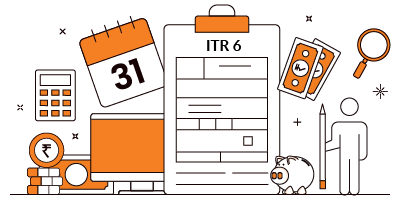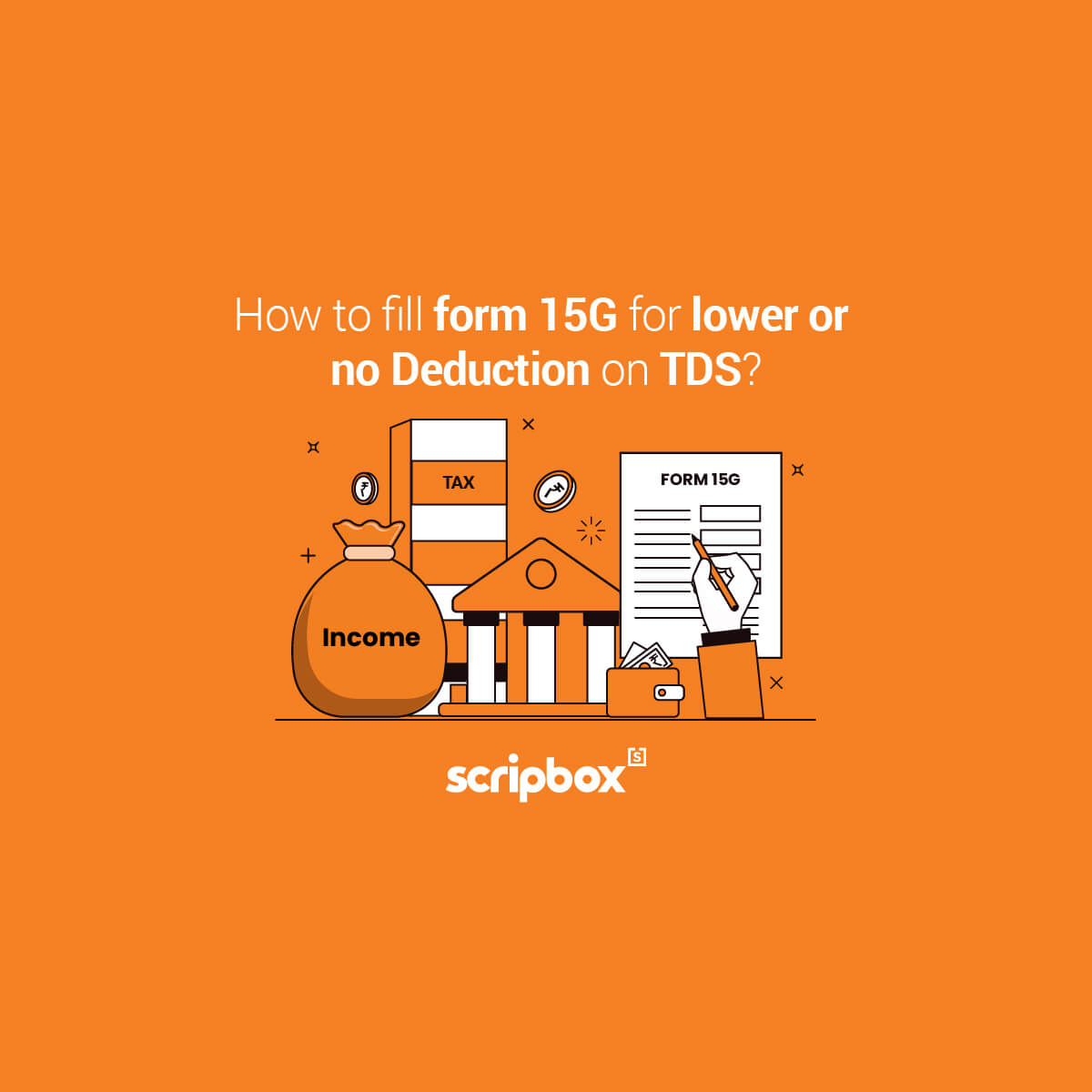News Update
The Income Tax Department has launched its new e-filing website on the 7th of June, 2021. This new portal will soon replace the existing portal www.incometaxindiaefiling.gov.in. With the main focus on a user-friendly e-filing experience for the taxpayers, the new portal ensures a quick and seamless ITR filing process. Currently, ITR-1 and ITR-4 (online and offline), and ITR-2 (offline) are available on the new portal. Other ITRs such as ITR-3, ITR-6, ITR-5, and ITR-7 will also be available. For the month of June 2021, the new ITR filing software will be free of cost for taxpayers. ITR will be immediately processed leading to a quick income tax refund. A single dashboard will represent all the tax-related interactions.
Income Tax Return ITR-6
ITR 6 form is applicable to companies that are not claiming any exemption under section 11 of the Income Tax Act, 1961. Further, ITR 6 is an annexure-less income tax return. Hence you need to attach any document while filing the income tax return. You file ITR 6 electronically on the e-filing portal on the income tax department. Along with the details of profit and loss, deductions, balance sheet, and others, you also need to provide the details of the audit of the books of accounts. Moreover, you can verify ITR 6 through the digital signature of the authorized signatory only. The other verification options are not available to taxpayers who are filing ITR 6.
Who can file ITR 6 Form?
ITR 6 form is applicable for an assessee who is a company as per section 2(17) of the Income Tax Act, 1961. However, any company which is required to file ITR 7 form cannot opt for ITR 6.
As per section 2(17) of the Income Tax Act, 1961 the following are considered as a company and are eligible to file ITR 6:
- An Indian domestic company incorporated under the Companies Act, 2013
- A body corporate or a company which is incorporated under a law of a country outside India i.e. a foreign company.
- An institution, association, or a body is to be a company by a general or special order of the board. It is irrespective of whether such an institution, association, or body is incorporated or not and whether it is Indian or not.
What is the structure of the ITR 6 Form?
The ITR 6 Form is divided into the following parts and schedules within these parts:
- Part A- general information
- Part B
- Schedules to ITR 6
- Verification of Income Tax Return
Recommended Read: How to File ITR 4 Online?
Part-A – General Information
- Basic Personal Information such as name, PAN, date of incorporation, address, taxpayer status, and sub-status
- Filing Status
- Mention the section under which you are filing the income tax return.
- If you are filing a revised/ defective/modified return then mention the receipt No. and date of filing an original return
- If you are filing the return in response to notice then mention the unique number/ Document Identification Number (DIN) and date of such notice/order.
- Representative
- If the return is being filed by a representative of the assessee then mention the details. These details are the name, capacity, address, and PAN of such a representative.
- Recognized Start-Up by DPIIT
- Mention whether you are recognized as a startup by DPIIT.
- If yes, then the provide startup recognition number allotted by the DPIIT
- Mention whether a certificate from the inter-ministerial board for certification is received?
- If yes then provide the certification number
- Whether declaration in Form-2 in accordance with para 5 of DPIIT notification dated 19/02/2019 has been filed before filing of the return?
- If yes then provide the date of filing Form-2
- Audit Information
- Are you liable for audit under section 44AB of the Income-tax Act? If yes, then provide the details of the audit.
- Provide the name of the auditor signing the tax audit report, Membership No, name of the auditor (proprietorship/ firm). Also, provide the Permanent Account Number (PAN)/ Aadhaar No. of the proprietorship/ firm and the date of an audit report.
- Holding Status
- Provide the name of the holding company and/ or subsidiary company as the case may be.
- Also, provide the PAN, Percentage of Shares held, and address of the company
- Business Organization
- Provide the name of the amalgamated company, amalgamated, resulting, demerged company as the case may be.
- Also, provide the PAN, Percentage of Shares held, and address of the company
- Key Persons
- Provide the particulars of Managing Director, Directors, Secretary and Principal officer(s) who have held the office during the previous year and the details of eligible person who is verifying the return.
- Mention the Name, designation, residential address, PAN/ Aadhaar No., Director Identification Number (DIN) issued by MCA, in case of Director.
- Shareholders Information
- Provide the particulars of persons who were beneficial owners of shares holding not less than 10% of the voting power at any time of the previous year
- Mention the name and address, percentage of shares held, and PAN
- Ownership Information
- In the case of an unlisted company, mention particulars of natural persons who were the ultimate beneficial owners, directly or indirectly, of shares holding not less than 10% of the voting power at any time of the previous year.
- In the case of a Foreign company, furnish the details of the immediate parent company. Provide name, address, country of residence, PAN, taxpayer’s registration number, or any unique identification number allotted in the country of residence.
- In the case of foreign companies, furnish the details of the ultimate parent company. Provide name, address, country of residence, PAN, taxpayer’s registration number, or any unique identification number allotted in the country of residence.
- Nature of Business and its Business
- Nature of company being a public sector company, company owned by the Reserve Bank of India, banking company, NBFC.
- Nature of business or profession, if more than one business or profession indicate the three main activities/ products (Other than those declaring income under section 44AE)
Part A-BS Balance Sheet as on 31st March
- Every assessee must fill Part A-BS Balance Sheet as on the 31st March of the financial year
- An assessee whose financial statements are drawn up in compliance with the Indian Accounting Standards (Ind AS) need not fill this part. The Indian Accounting Standards (Ind AS) is specified in Annexure to the Companies (Indian Accounting Standards) Rules, 2015.
- In the case of amalgamation, you must provide the balance sheet as on the date of amalgamation in respect of the business or profession carried out during the financial year.
- Ensure that the figures you report in the balance sheet in ITR 6 should match with the audited balance sheet. This is applicable in case the accounts were audited by an auditor. In case there is any other activity that does not form part of the books of accounts of business or profession then you need not include it in this balance sheet.
- You must fill the details of related parties in the Balance Sheet as per Schedule III of the Companies Act, 2013
- For every domestic company that is liable to maintain books of accounts under section 44AA, it is mandatory to fill the balance sheet in ITR 6. In the case of any non-compliance, the ITR will be treated as defective u/s 139(9) of the Act.
Part A-BS – Ind AS Balance Sheet as on 31st March
Part A-BS- Ind AS is applicable to a company whose financial statements are drawn up in compliance to the Indian Accounting Standards. The Indian Accounting Standards are specified in Annexure to the Companies (Indian Accounting Standards) Rules, 2015.
- In the case of amalgamation, you must provide the balance sheet as on the date of amalgamation in respect of the business or profession carried out during the financial year.
- Ensure that the figures you report in the balance sheet in ITR 6 should match with the audited balance sheet. This is applicable in case the accounts were audited by an auditor. In case there is any other activity that does not form part of the books of accounts of business or profession then you need not include it in this balance sheet.
- You must fill the details of related parties in the Balance Sheet as per Schedule III of the Companies Act, 2013
- For every domestic company that is liable to maintain books of accounts under section 44AA, it is mandatory to fill the balance sheet in ITR 6. In the case of any non-compliance, the ITR will be treated as defective u/s 139(9) of the Act.
Part A Manufacturing Account Manufacturing Account for the financial year
- You need to fill items 1 to 3 in a case where regular books of accounts are maintained, otherwise fill items 61 to 62 as applicable
- Fill up the details of the Manufacturing Account for the financial year. The details such as the opening inventory, purchases, direct wages, direct expenses, factory overheads, and closing stock.
- At item No. 3 of this part, the cost of goods produced is computed on the basis of figures reported for opening inventory, etc. which is then transferred to item No. 11 of the trading account.
- However, in case you were not required to maintain regular books of account of the business or profession then fill up only the mandatory details. These details are sought at item No. 61 (if income taxable u/s 44AE) or 62 (if income taxable u/s 44B/ 44BB/ 44BBA/ 44BBB) of Part A – P&L, whichever is applicable.
Part A-Trading Account Trading Account for the financial year
- You need to fill items 4 to 12 in a case where you are maintaining the regular books of accounts, otherwise, fill items 61 to 62 as applicable.
- In this part, fill up the details of the Trading Account for the financial year, such as Sales/Gross receipts of business/ profession, duties, taxes and cess, etc. in respect of supplies. Also provide the closing stock and opening stock of finished goods, purchases, direct expenses, duties/ taxes, etc. in respect of purchases. At item No. 12 of this part, the gross profit from business/profession is computed on the basis of figures reported for sales, etc. which is then transferred to item No. 13 of the profit and loss account.
- In case you are engaged in intra-day trading activity during the year then fill up the summary details in respect of such activity at columns 12a and 12b i.e turnover and income.
- However, in case you were not required to maintain regular books of account of the business or profession then fill up only the mandatory details. Such details are sought at item No. 61 (if income taxable u/s 44AE) or 62 (if income taxable u/s 44B/ 44BB/ 44BBA/ 44BBB) of Part A – P&L, whichever is applicable, and leave out this part.
Part A-P& L Profit and Loss Account for the financial year
- You need to fill items 13 to 60 in a case where you maintain the regular books of accounts, otherwise, fill items 61 to 62 as applicable
- Fill up the details of the profit and loss account for the financial year, in respect of the business or profession carried out during the financial year
- However, in case you were not required to maintain regular books of account of the business or profession then fill up only the mandatory details. Such details are sought at item No. 61 (if income taxable u/s 44AE) or 62 (if income taxable u/s 44B/ 44BB/ 44BBA/ 44BBB) of Part A – P&L, whichever is applicable, and leave out this part.
- Ensure that the figures you report in the P&L a/c in ITR 6 should match with the audited P&L a/c. This is applicable in case the accounts were audited by an auditor. In case there is any other activity that does not form part of the books of accounts of business or profession then you need not include it in this profit and loss account.
Part A-P& L Profit & Loss Account for the financial year (Item 61)
- Fill up item No. 61 only in case you are declaring income from the business of plying, hiring or leasing of goods carriages on a presumptive basis as per section 44AE.
- Ensure that you do not include the receipts/income from such business activity in the business or profession at item Nos. 1 to 60.
- Enter the name of business, business code, and description of the business
- Enter the registration No., ownership, tonnage capacity, tenure of ownership, and presumptive income against each such goods carriage
- For each goods, carriage mention the number of months for which they were engaged in plying, hiring or leasing.
- In case you have actually earned income at rates higher than the specified rate per vehicle per month, then you have to declare income at such a higher rate.
- However, if the income being declared is less than the specified rates per vehicle, or the number of vehicles exceeds ten at any time during the year, it is mandatory to maintain books of accounts. Additionally, get the same audited under section 44AB. In such cases, mention the details of tax audit in Part-A (General) – Audit information. Further, report the details of income, etc. in the regular columns i.e. item No. 1 to 60.
Part A-P& L Profit & Loss Account for the financial year (column 62)
In case you are a foreign company whose:
- total income comprises solely profits and gains from a business referred to in sections 44B, 44BB, 44BBA or 44BBB
- fill up the summary details in respect of such activity at column 62 i.e. gross receipts/ turnover and net profit.
Part A Manufacturing Account Ind-AS Manufacturing Account for the financial year
- This part is applicable to a company whose financial statements are drawn up in compliance to the Indian Accounting Standards. Further, the Indian Accounting Standards is specified in Annexure to the Companies (Indian Accounting Standards) Rules, 2015.
- Fill this manufacturing account in case you are a company whose financial statements are drawn up in compliance with the Indian Accounting Standards (Ind AS).
- In this part, fill up the details of the Manufacturing Account for the financial. The details such as the opening inventory, purchases, direct wages, direct expenses, factory overheads, and closing stock. At item No. 3 of this part, the cost of goods produced is computed on the basis of figures reported for opening inventory, etc. which is then transferred to item No. 11 of the trading account.
Part A-Trading Account Ind-AS Trading Account for the financial year
- This part is applicable to a company whose financial statements are drawn up in compliance with the Indian Accounting Standards. Further, the Indian Accounting Standards as specified in Annexure to the Companies (Indian Accounting Standards) Rules, 2015.
- Here fill the details of the Trading Account for the financial year. The details such as Sales/Gross receipts of business/profession, duties, taxes and cess, etc. in respect of supplies. Also provide details of closing stock and opening stock of finished goods, purchases, direct expenses, duties/ taxes, etc. in respect of purchases.
- At item No. 12 of this part, the gross profit from business/profession is computed on the basis of figures reported for sales, etc. which is then transferred to item No. 13 of the profit and loss account.
- In case you are engaged in intra-day trading activity during the year, then fill up the summary details in respect of such activity at columns 12a and 12b viz. turnover and income.
Part A-P& L Ind-AS Profit and Loss Account for the financial year
- This part is applicable to a company whose financial statements are drawn up in compliance with the Indian Accounting Standards. Further, the Indian Accounting Standards as specified in Annexure to the Companies (Indian Accounting Standards) Rules, 2015.
- Fill in the details of the profit and loss account for the financial year 2019-20, in respect of the business or profession carried out during the financial year
- In case you were required to maintain regular books of accounts for the business or profession, then fill the details at item No. 13 to 62.
- Ensure that the figures you report in the P&L a/c in ITR 6 should match with the audited P&L a/c. This is applicable in case the accounts were audited by an auditor. In case there is any other activity that does not form part of the books of accounts of business or profession then you need not include it in this profit and loss account.
Part A- OI (Other Information)
- Part A- OI is applicable and mandatory if you are liable for an audit under section 44AB. You must mandatorily fill in the information sought at item No. 1 to 17
- Provide the details of allowances and disallowances as per the Income Tax Act.
- Further, the figures mentioned against those items which are also required to be reported in the tax audit u/s 44AB should match with the information given in the tax audit report
PART A- QD (Quantitative Details)
- Part A- QD is applicable and mandatory if you are liable for an audit under section 44AB.
- In Part A-QD, provide the quantitative details of trading and manufacturing accounts in respect of principal items.
- In case of trading concern, fill up the quantitative details of opening stock, purchase, and sales during the year, and closing stock for principal items.
- In case of a manufacturing concern, fill up the quantitative details of the main items of raw materials. Provide details of opening stock, purchase, consumption, and sales during the year, closing stock & yield of finished products. Also, provide the quantitative details of main items of finished products and by-products. For these main items provide the opening stock; purchase, manufacturing, and sales during the year; closing stock).
Part A – OL Receipt and payment account of company under liquidation
- Fill this part only in case you are a company under liquidation. Provide the details of opening and closing balances of receipts and payments in requisite columns.
Part B – TI Computation of total income
- Compute the total income as per the Income Tax Act, 1961 for the previous year
- Now, classify your income from each source under the appropriate heads of income. The five heads of income are income from house property, income from business or profession, capital gains, and income from other sources.
- Set off any loss from any source against the income from any other source, under the same head of income for the current year i.e. the intra-head set-off.
- Thereafter, proceed to set off the remaining loss under various heads of income. You can set off against the income under other heads of income.
- Now set off the losses brought forward from earlier years under certain heads. You set off from the remaining current year’s income under other heads.
- The remaining income after set-off is the gross total income for the financial year
- Lastly, claim the deductions claimed under Chapter VI-A. The gross total income minus the deductions are the net taxable income which is chargeable to tax.
Part B – TTI – Computation of tax liability on total income
- Compute the total tax liability on total income as per the normal applicable rates. Now compare it with the Minimum Alternate Tax (MAT) payable on book profit u/s 115JB.
- The gross tax liability will be taxable as per normal rates and MAT whichever is higher. Now against the tax liability claim the MAT credit and tax reliefs under sections 90/90A/91. The amount post such claims will be the net tax liability for the year.
- Compute the interest and fees payable, if any for various defaults and add to the aggregate tax liability.
- From this net amount, payable or refundable deduct any tax paid earlier. You can deduct prepaid taxes such as advance tax, TDS, TCS, and self assessment tax.
Part- Tax Payments in ITR 6
Part –A – Details of payments of Advance Tax and Self-Assessment Tax
- Enter the details of payment of advance tax or self-assessment tax.
- Provide the BSR code, challan serial number, date of deposit, and amount.
Part- B – Details of Tax Deducted at Source on income
- Enter the details of TDS taxes deducted at source on income other than salary. Ensure that the TDS amount is as per Form 16A or Form 16B, or Form 16C which is issued by the tax deductor.
- Provide the TDS credit relating to self/other people, PAN/Aadhaar No. of other people, TAN of the Deductor/PAN, or Aadhaar No. of Tenant/Buyer.
- Mention the Unclaimed TDS brought forward (b/f), TDS of the current financial year, TDS claim amount, the corresponding receipt against the claim, carry forward TDS amount.
Part- C – Details of Tax Collected at Source (TCS)
- Enter the details of TCS taxes collected at the source during the year. Ensure that the TCS amount is as per Form 27D which is issued by the collector.
- Provide the Tax deduction and Tax Collection Account Number of the Collector, Name of the Collector, Unclaimed TCS brought forward from previous years.
- Mention the TCS against the current financial year, TCS claim amount, and carry forward TCS. You must remember that you can claim TCS only if you offer income as well for tax.
Verification of the ITR 6 Form
- Under verification of the ITR 6 Form, you need to enter the name, father’s name, and PAN of the person who is filing the return.
- In the case of a company, only the managing director can verify the income tax return. However, if he/ she is not available for some unavoidable reasons then any of the directors can verify the ITR.
- Before verifying the ITR always ensure that the schedules, parts, and every detail are as per the income tax rules and income tax act, 1961. Any false statement in the return or in the accompanying schedules can lead to a prosecution under section 277 of the Income-tax Act, 1961.
- You can verify ITR 6 through a digital signature only.
Schedules to ITR 6 Income Tax Return
Schedules to ITR 6 for Income and Expenses
Schedule HP- Details of Income from House Property
Schedule BP – Computation of income from business or profession
Schedule DPM Depreciation on Plant and Machinery (Other than assets on which full capital expenditure is allowable as a deduction under any other section)
Schedule DOA Depreciation on other assets (Other than assets on which full capital expenditure is allowable as a deduction)
Schedule DEP Summary of depreciation on assets (Other than on assets on which full capital expenditure is allowable as a deduction under any other section)
Schedule DCG Deemed Capital Gains on sale of depreciable assets
Schedule ESR Expenditure on scientific Research etc. (Deduction under section 35 or 35CCC or 35CCD)
Schedule CG Capital Gains
Schedule 112A From the sale of equity share in a company or unit of equity oriented fund or unit of a business trust on which STT is paid under section 112A
Schedule 115AD(1)(b)(iiii)- Proviso From the sale of equity share in a company or unit of equity oriented fund or unit of a business trust on which STT is paid under section 112A
Schedule OS Income from other sources
Schedule CYLA Details of Income after Set off of current year losses
Schedule BFLA Details of Income after Set off of Brought Forward Losses of earlier years
Schedule CFL Details of Losses to be carried forward to future years
Schedule UD Unabsorbed depreciation and allowance under section 35(4)
Schedule ICDS Effect of Income Computation Disclosure Standards on profit
Schedules to ITR 6 for Deductions
Schedule 10AA Deduction under section 10AA
Schedule 80G Details of donations entitled for deduction under section 80G
Schedule 80GGA Details of donations for scientific research or rural development
Schedule RA Details of donations to research associations etc. [deduction under sections 35(1)(ii) or 35(1)(iia) or 35(1)(iii) or 35(2AA)]
Schedule 80-IA Deductions under section 80-IA
Schedule 80-IB Deductions under section 80-IB
Schedule 80-IC or 80-IE Deductions under section 80-IC or 80-IE
Schedule VI-A Deductions under Chapter VI-A
Schedules to ITR 6 for Tax Computation
Schedule SI Income chargeable to tax at special rates
Schedule EI Details of Exempt Income (Income not to be included in Total Income or not chargeable to tax)
Schedule PTI Pass-Through Income details from business trust or investment fund as per section 115UA, 115UB
Schedule MAT Computation of Minimum Alternate Tax payable under section 115JB
Schedule MATC Computation of tax credit under section 115JAA
Schedule- DDT Details of tax on distributed profits of domestic companies and its payment
Schedule- BBS Details of tax on distributed income of a domestic company on buyback of shares
Schedule TPSA Details of Tax on secondary adjustments as per section 92CE(2A)
Schedule FSI Details of Income from outside India and tax relief (available only in case of resident)
Schedule TR Summary of tax relief claimed for taxes paid outside India (available only in case of resident)
Schedules to ITR 6 for Other Declarations
Schedule FA Details of Foreign Assets and Income from any source outside India
Schedule SH-1 Shareholding of Unlisted Company (other than a company that is registered under section 8 of the Companies Act, 2013 (or section 25 of the Companies Act, 1956) or a company limited by guarantee under section 3(2) of Companies Act, 2013 or a start-up for which Schedule SH-2 is to be filed-up)
Schedule SH-2 Shareholding of Start-Ups
Schedule AL-1 Assets and liabilities as at the end of the year (mandatorily required to be filled up by an unlisted company) (other than a start-up for which Schedule AL-2 is to be filled up)
Schedule AL-2 Assets and liabilities as at the end of the year (applicable for start-ups only)
Schedule DI Details of Investment
Schedule GST Information regarding turnover/ gross receipt reported for GST
Schedule FD Break-up of payments/receipts in Foreign currency (to be filled up by the assessee who is not liable to get accounts audited u/s 44AB)
Learn How to File ITR 2?
Related Articles
- Income Tax Return ITR-6
- Who can file ITR 6 Form?
- What is the structure of the ITR 6 Form?
- Part-A – General Information
- Part A-BS Balance Sheet as on 31st March
- Part A-BS – Ind AS Balance Sheet as on 31st March
- Part A Manufacturing Account Manufacturing Account for the financial year
- Part A-Trading Account Trading Account for the financial year
- Part A-P& L Profit and Loss Account for the financial year
- Part A-P& L Profit & Loss Account for the financial year (Item 61)
- Part A-P& L Profit & Loss Account for the financial year (column 62)
- Part A Manufacturing Account Ind-AS Manufacturing Account for the financial year
- Part A-Trading Account Ind-AS Trading Account for the financial year
- Part A-P& L Ind-AS Profit and Loss Account for the financial year
- Part A- OI (Other Information)
- PART A- QD (Quantitative Details)
- Part A – OL Receipt and payment account of company under liquidation
- Part B – TI Computation of total income
- Part B – TTI – Computation of tax liability on total income
- Part- Tax Payments in ITR 6
- Verification of the ITR 6 Form
- Schedules to ITR 6 Income Tax Return
























Show comments